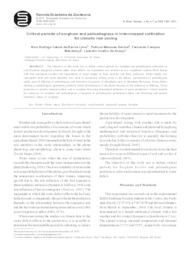Critical periods of sorghum and palisadegrass in intercropped cultivation for climatic risk zoning.
Critical periods of sorghum and palisadegrass in intercropped cultivation for climatic risk zoning.
Author(s): SANTOS, P. M.; MENDONCA, F. C.
Summary: The objective of this work was to define critical periods for sorghum and palisadegrass cultivated on crop-livestock integrated systems under water deficit. An experiment was carried out in a completely random block design with four treatments (control and interruption of water supply in three periods) and three replicates. Water supply was interrupted until soil water humidity was close to permanent wilting point at the phases: germination of palisadegrass seeds; start of tillering of palisadegrass and initiation of panicles of shorghum; start of shorghum flowering. Water deficit starting at palisadegrass germination delayed intital development of the plants because of the reduction in tillering. Water restriction at panicle initiation phase and at sorghum flowering determined reduction of grain production. Critical periods for intercrop of sorghum and palisadegrass correspond to palisadegrass germination phase and flowering and panicle inititation phase of sorghum.
Publication year: 2011
Types of publication: Journal article
Observation
Some of Embrapa's publications are published as ePub files. To read them, use or download one of the following free software options to your computer or mobile device. Android: Google Play Books; IOS: iBooks; Windows and Linux: Calibre.
Access other publications
Access the Agricultural Research Database (BDPA) to consult Embrapa's full library collection and records.
Visit Embrapa Bookstore to purchase books and other publications sold by Embrapa.

